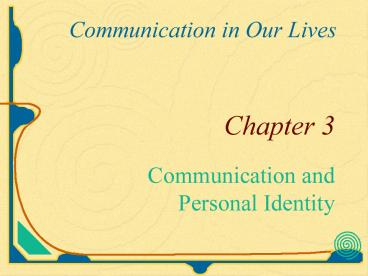Communication and Personal Identity - PowerPoint PPT Presentation
1 / 20
Title:
Communication and Personal Identity
Description:
Title: Communication and Personal Identity Author: Linda Steck Last modified by: Linda Steck Created Date: 1/27/2002 11:05:46 PM Document presentation format – PowerPoint PPT presentation
Number of Views:225
Avg rating:3.0/5.0
Title: Communication and Personal Identity
1
(No Transcript)
2
The Self Arises in Communication with Others
- Self-fulfilling prophecies involve acting in ways
that bring about our expectations or judgments of
ourselves.
3
The Self Arises in Communication with Others
- Communication with family
- Direct definition is communication that
explicitly tells us who we are by labeling us and
our behaviors. - Identity scripts are guides for living that
define our roles and how we are to play them. - Attachment styles are patterns of parenting that
tell children who they are, who others are, and
how to approach relationships.
4
Attachment Styles
- A secure style occurs when the caregiver responds
in a consistently attentive and loving way. - A fearful style is cultivated when the caregiver
in the first bond communicates in negative,
rejecting, or abusive ways to the child. - A dismissive style is promoted by caregivers who
are disinterested, rejecting, or abusive. - The anxious/resistant style is inconsistent
treatment from the caregiver.
5
Views of Self
Positive
Negative
Secure
Anxious/ Resistant
Positive
Views of Others
Dismissive
Fearful
Negative
6
The Self Arises in Communication with Others
- Communication with peers
- Reflected appraisal refers to the idea that we
reflect the appraisals that others make of us. - Social comparison involves comparing ourselves
with others to form judgments of our own talents,
abilities, and qualities.
7
Influences on Self-Concept
8
Influences on Self-Concept
Self-Concept
9
The Self Arises in Communication with Others
- Communication with society
- The perspectives of society (generalized other)
are revealed to us in two ways - Through interactions with others who have
internalized cultural values and pass them on to
us - Through media and social institutions such as
judicial and educational systems
10
- The self arises in communication and is a
multidimensional process that involves importing
and acting from social perspectives.
11
The Self is Multidimensional
- There are many dimensions to self
- Physical
- Cognitive
- Emotional
- Social roles
- Sense of morality
12
The Self is a Process
- We are not born with selves but acquire them. We
change again and again during life. We are self
renewing and ever growing. - Ego boundaries define where an individual stops
and the rest of the world begins. - Babies literally have no ego boundaries.
13
The Self Internalizes Social Perspectives
- We rely on social perspectives to define
ourselves and to guide how we think, act, and
feel. - Particular others are specific individuals who
are significant to us. - The generalized other is the collection of rules,
roles, and attitudes endorsed by the whole social
community in which we live.
14
Social Perspectives on the Self are Constructed
and Variable
- Social perspectives are constructed in particular
cultures at specific times. - The constructed and arbitrary nature of social
values differs from culture to culture. - Just as our culture shapes us, so we shape our
culture. - Each of us has the responsibility to speak out
against social perspectives that we perceive as
wrong or harmful.
15
Guidelines for Improving Self-Concept
- Make a firm commitment to change.
- Gain knowledge as a basis for change.
- Set goals that are realistic and fair.
16
Guidelines for Improving Self-Concept
- Create a context that supports change.
- Uppers are people who communicate positively
about us and who reflect positive appraisals of
our self-worth. - Downers are people who communicate negatively
about us and our self-worth. - Vultures are an extreme form of downers.
- Self-sabotage involves telling ourselves we are
no good, we cant do something, there is no
point, etc.
17
Experiencing Communication in our Lives . . .
- View the following video clip and then answer
the questions that follow based on material
presented in this chapter. A script of the
scenario can be found at the end of Chapter 3.
18
Wadsworth Thomson Wood Scenarios
19
- Identify examples of direct definition in this
scenario. - Identify examples of reflected appraisal. What
appraisals of her son and daughter does Kate
reflect to them? - What do Emma and Jeremys responses to Kate
suggest about their acceptance of her views of
them? - To what extent does Kates communication with her
children reflect gender expectations in Western
culture? - You may go to your student CD that accompanies
the text to compare your answers to Julia Woods.
20
(No Transcript)

